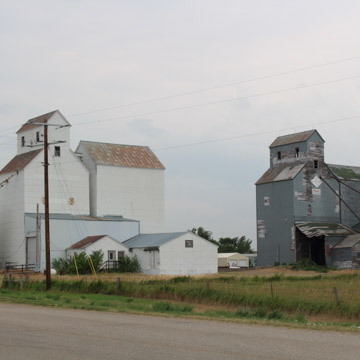These grain elevators stand beside the railroad in Agar, which is located in rural Sully County in the center of South Dakota. Situated a short distance east of the Missouri River, the county boasts rich alluvial farm lands producing wheat, corn, and sunflowers. These two structures exemplify the late-nineteenth- and early-twentieth-century elevators that dot the rural South Dakota landscape.
Construction on the first of the Agar elevators was completed on November 1, 1910, shortly after the town was founded. Agar was platted when the Chicago and Northwestern Railway Company laid its line through Sully County. The second elevator was actually built in 1915 in Eakin, but was relocated to Agar in the late 1940s.
The monolithic forms are derived from their function. At the top of the elevator is the headhouse, recognizable on the exterior by its gable roof and windows. Here, the grain that traveled up the elevator leg via a pulley system is transferred through a moveable spout into numerous bins. The wooden elevators are built of cribbed lumber to withstand the lateral loads of the grain stored within. When ready for distribution, the grain flows through a spout at the bottom of each bin, into a hopper, and then onto the waiting train car or, later, trucks.
The average capacity of South Dakota’s early elevators was 15,000 bushels. In 1903 there were 850 elevators in the state, but by 1991 there were less than 350 as large corporate companies replaced small, local farm grain associations and as larger steel or concrete elevators with a capacity of 250,000 bushels replaced earlier wooden models. Today, only one of the Agar elevators is still in service.








